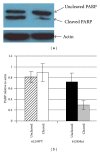An inherited heteroplasmic mutation in mitochondrial gene COI in a patient with prostate cancer alters reactive oxygen, reactive nitrogen and proliferation
- PMID: 23509693
- PMCID: PMC3591245
- DOI: 10.1155/2013/239257
An inherited heteroplasmic mutation in mitochondrial gene COI in a patient with prostate cancer alters reactive oxygen, reactive nitrogen and proliferation
Abstract
Mitochondrial DNA (mtDNA) mutations have been found in many cancers but the physiological derangements caused by such mutations have remained elusive. Prostate cancer is associated with both inherited and somatic mutations in the cytochrome c oxidase (COI) gene. We present a prostate cancer patient-derived rare heteroplasmic mutation of this gene, part of mitochondrial respiratory complex IV. Functional studies indicate that this mutation leads to the simultaneous decrease in cytochrome oxidation, increase in reactive oxygen, and increased reactive nitrogen. These data suggest that mitochondrial DNA mutations resulting in increased reactive oxygen and reactive nitrogen generation may be involved in prostate cancer biology.
Figures






References
-
- Zhadanov SI, Grechanina EY, Grechanina YB, et al. Fatal manifestation of a de novo ND5 mutation: insights into the pathogenetic mechanisms of mtDNA ND5 gene defects. Mitochondrion. 2007;7(4):260–266. - PubMed
-
- Gómez-Zaera M, Abril J, González L, et al. Identification of somatic and germline mitochondrial DNA sequence variants in prostate cancer patients. Mutation Research. 2006;595(1-2):42–51. - PubMed
Publication types
MeSH terms
Substances
Grants and funding
LinkOut - more resources
Full Text Sources
Other Literature Sources
Medical

